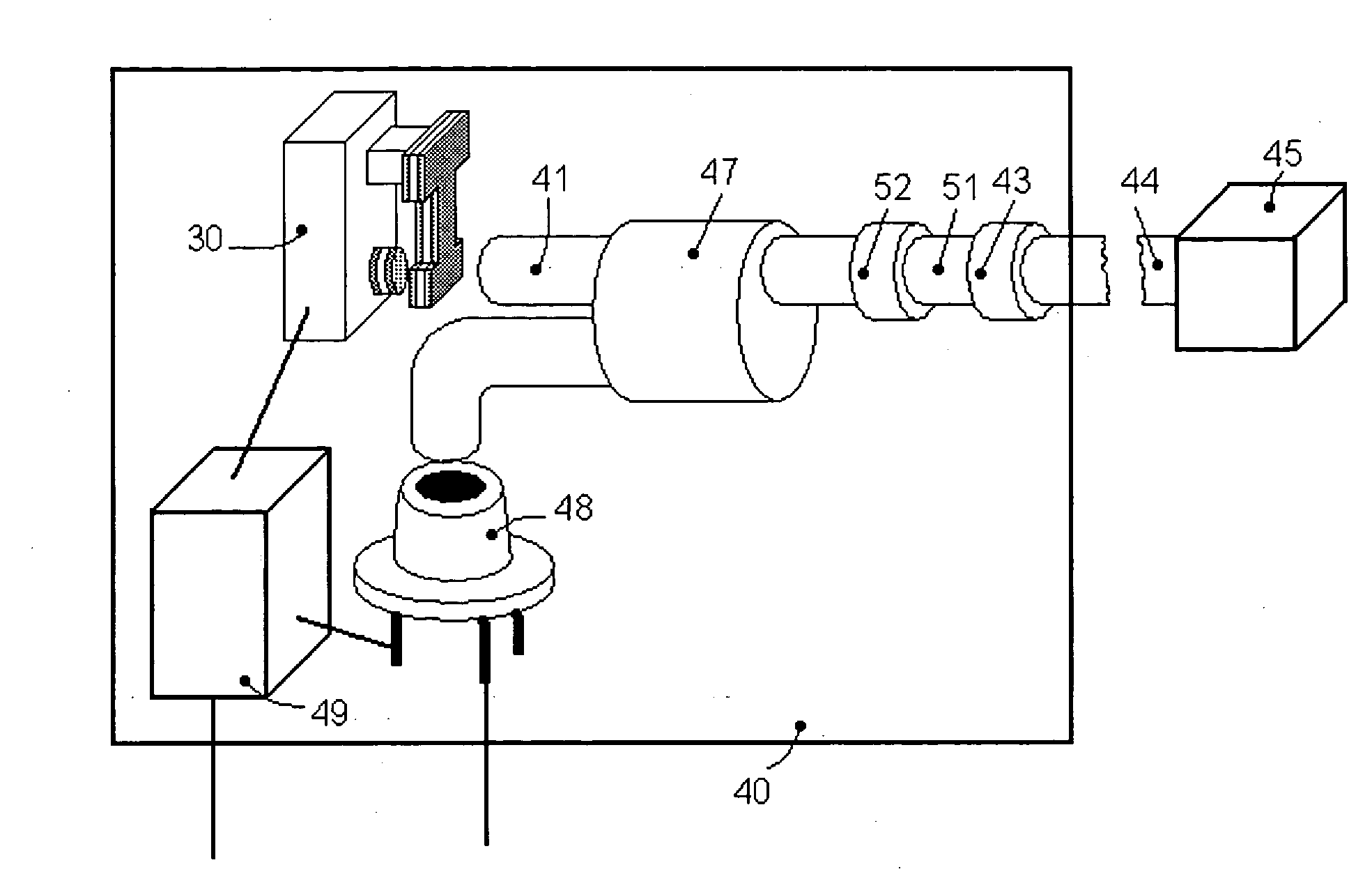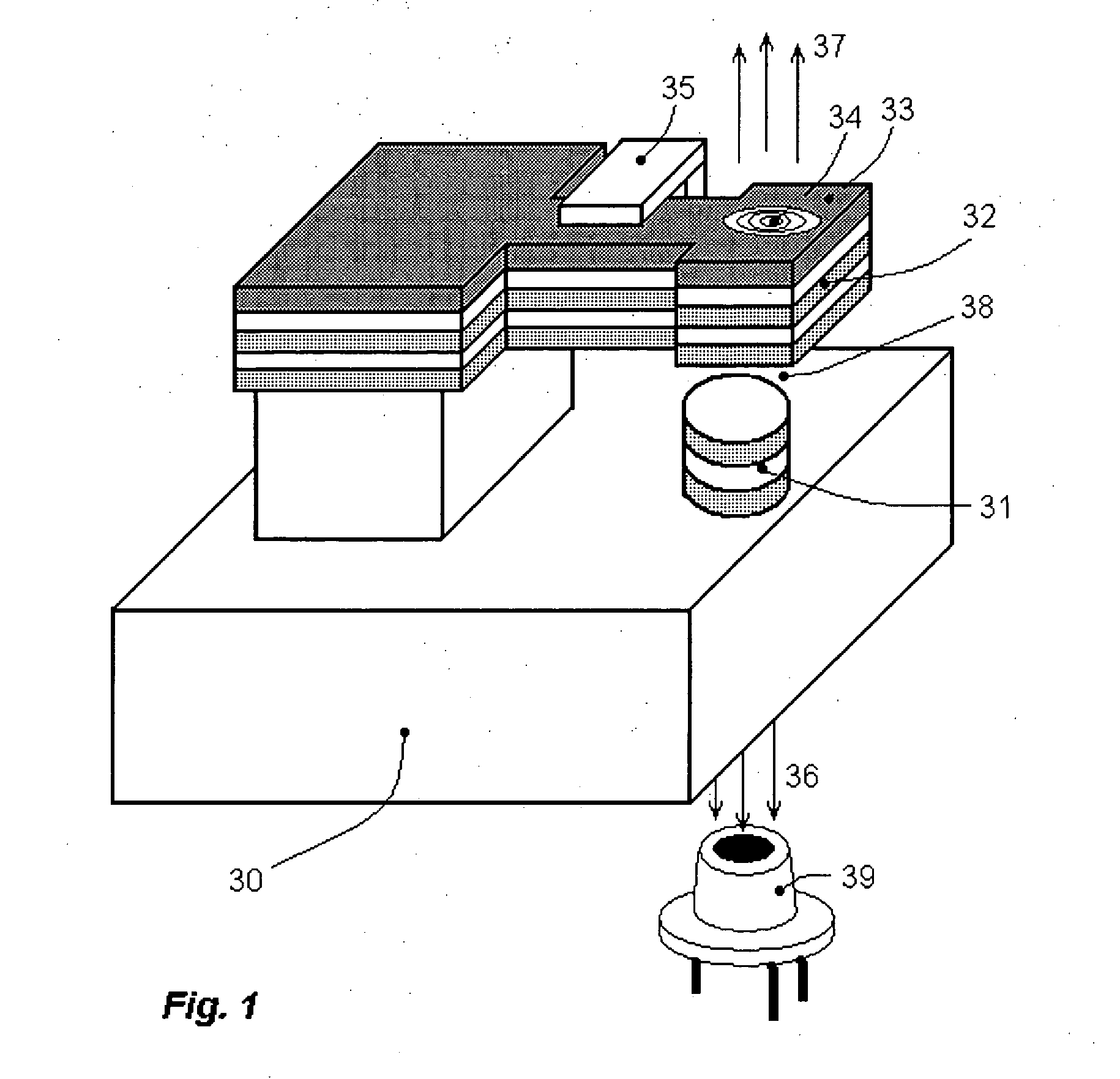[0005] We have, in contrast, discovered that combining a new type of laser, a vertical cavity, surface emitting laser (VCSEL), with an integrated microelectromechanical (MEMS) tuning mechanism as an interrogating instrument with sensors of many different types will enable new, less expensive and more reliable class of optical sensor systems.
[0007] It is known that Bragg gratings patterned into optical fibers or other waveguides may be used to detect physical stimuli caused by various physical parameters, such as, for example, strain, pressure, temperature, and current (via the associated magnetic fields) at the location of the gratings. See for example U.S. Pat. Nos. 4,806,012 and 4,761,073 both to Meltz, et al; U.S. Pat. No. 5,380,995 issued to E. Udd; U.S. Pat. No. 6,024,488 issued to J. Wu; and the publication authored by Kersey, A.D., et.al. [10.sup.th
Optical Fiber Sensors Conference, Glasgow, October 1994, pp.53-56]. Generally, in such a sensor, the core and / or cladding of the
optical fiber (or planar
waveguide) is written with
periodic grating patterns effective for selectively reflecting a narrow
wavelength band of light from a broader
wavelength band launched into the core (
waveguide layer in the
waveguide). The spectral positions of sharp maxima or minima in the reflected or
transmitted light intensity spectra indicate the intensity of strain, temperature, pressure,
electrical current, or
magnetic field variations at the location of the
grating. The mechanism of the spectral position variability lies in changes in either the grating period or the indices of
refraction, or both, which can be affected by various environmental physical stimuli, such as, for example,
temperature and pressure. Frequently, more than one stimulus or physical parameter affects the sensors at the same time, and compensation must be designed into the sensor or the measurement technique for all the variables but one (which can be accomplished by many physical, optical and electronic techniques known in the art). The typical sensitivity limits of
fiber grating sensors in the current art are generally about 0.1.degree. C. to 1.degree. C. and / or 1 microstrain or higher (depending on the packaging and / or embedding of the sensor), respectively. Advantages of a
spectral shift method of sensor interrogations include the high accuracy of wavelength determination (akin to the advantages of measuring frequency instead of magnitude) and
immunity to "
optical noise" due to fluctuations in
fiber transmission amplitude (microbending losses, etc.). The use of Bragg gratings also allows the
multiplexing of many sensors on the same fiber via wavelength dependent
multiplexing techniques (WDM), e.g., dividing the total
wavelength band into sections dedicated to individual sensors.
[0011] A new kind of laser, a
vertical cavity surface emitting laser (VCSEL), has recently been developed. Generally, VCSELs are made completely with
wafer-level
processing and the chips emit from the direction of the broad surface of the
wafer, rather than having to be cleaved out of the
wafer in order to have an exposed p-n junction edge from which to emit, as in older art. This enables another benefit to be designed into the wafer structure--tunability. This is done with micromachining (MEMS) technology by placing a stack of optical
layers, forming a mirror, in front of the emitting surface in such a way that the stack can be varied in its distance from the emitting surface by piezoelectric, magnetic, electrostatic or some other micro-actuating means. The groups of C. J. Chang-Hasnain (US Patent, [IEEE J. on Selected Topics in
Quantum Electronics, V 6, N 6, November 2000, p. 978]), J. S. Harris Jr. (U.S. Pat. No. 5,291,502, [Appl. Phys. Lett. 68 (7), February 1996 p. 891]), and Vakhshoori [
Electronics Letters, May 1999, V. 35, N.11 p. 900] have shown the potential for making tunable VCSELs with MEMS tuning mechanisms with wide tuning ranges and fast tuning speeds combined with good
coherence length (exceeding 2 meters) and extreme reliability of the
tuner mechanism (it survives hundreds of megacycles). Tunable VCSELs are relatively simple to manufacture, exhibit
continuous mode-hop-free tunability over a wide spectrum, and offer more than an
order of magnitude lower cost as compared to prior art tunable lasers or optical spectrometers. Integrated, MEMS-tunable VCSELS make possible truly affordable and accurate optical sensor systems by combining low cost detectors and low cost excitation sources, one or the other of which is very expensive in the prior art systems with the accuracy and resolution considerably exceeding those of the prior art lasers.
[0012] We use such VCSEL technology in a novel way to provide a means of
optical wavelength scanning Bragg grating and etalon
resonance sensors of all types with integrated, MEMS-tunable VCSELs in order to measure various physical parameters at several orders of magnitude lower cost than prior art, with the added benefits of enhanced accuracy, ruggedness and reliability.
[0023] The illustrative non-limiting exemplary implementations described herein provide low cost, workable, practical diagnostic systems which function in cooperation with remote
optical fiber sensor systems to measure static and dynamic strain, pressure, temperature, electrical currents and magnetic fields as well as acoustic or vibratory perturbations of items or structures and chemical and biological parameters. The
remote sensors may be disposed on structures made of
metal, plastic, composite, or any other materials that expand, contract, or vibrate, or the sensors may be embedded within such structures or immersed in liquids or gasses. The implementations also provide a wavelength-tunable VCSEL, tunable smoothly and monotonically, and in particular, linearly or sinusoidally tunable with time. The implementations further provide individual illumination of each sensor, thereby allowing all the tunable VCSEL power to be resident in a single narrow wavelength band at any instant in time. Ultra-
fine tuning of tunable VCSELs to a few parts per million will allow another
order of magnitude increase in precision due to higher resolution and improved computational methods and
statistical processing. The very
low mass of the MEMS tuning mechanisms allow very high tuning speeds with very low
hysteresis, providing the ability to average out optical
noise in the sensor systems with many data points and allowing very close spacing of data in wavelength.
 Login to View More
Login to View More 


